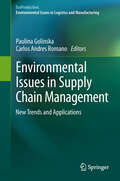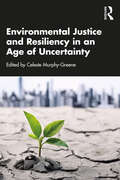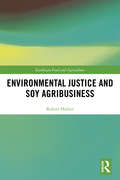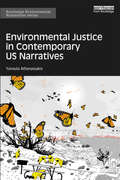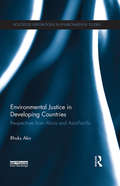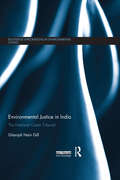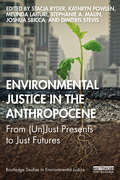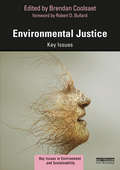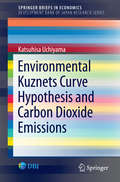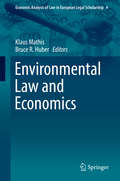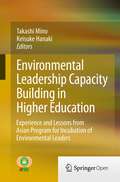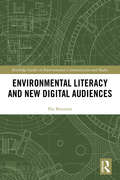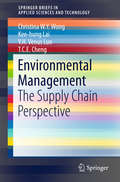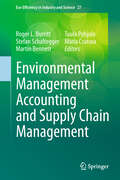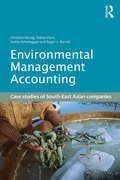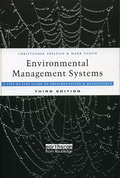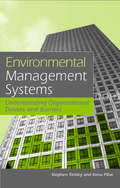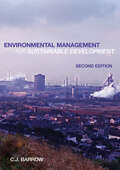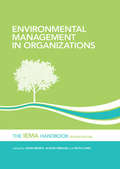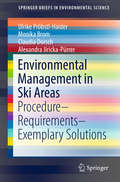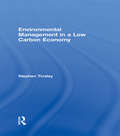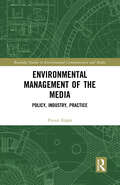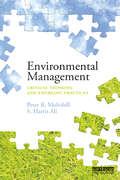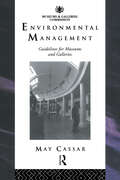- Table View
- List View
Environmental Issues in Supply Chain Management: New Trends and Applications
by Paulina Golinska Carlos Andres RomanoThe aim of the book is to present the emerging environmental issues in organization and management of complex supply chains. The book includes set of solutions which show different stakeholders' viewpoints on sustainability. The scope of book takes into consideration how the emerging environmental regulation might be transformed into business practices. Therefore, the authors present the innovative approach to eco-friendly organization and coordination of logistics processes and supply chain configuration. A broad scope of practical solutions from different countries and industries is provided
Environmental Justice and Resiliency in an Age of Uncertainty
by Celeste Murphy-GreeneThis book examines the issue of environmental justice across 11short chapters, with the aim of creating a resilient society. Starting with a history of the environmental justice movement, the book then moves on to focus on various current environmental issues, analyzing how these issues impact low-income and minority communities. Topics covered include smart cities and environmental justice, climate change and health equity, the Flint Water Crisis, coastal resilience, emergency management, energy justice, procurement and contract management, public works projects, and the impact of COVID-19. Each chapter provides a unique perspective on the issues covered, offering practical strategies to create a more resilient society that can be applied by practitioners in the field. Environmental Justice and Resiliency in an Age of Uncertainty will be of interest to upper level undergraduate and graduate students studying race relations, environmental politics and policy, sustainability, and social justice. It will also appeal to practitioners working at all levels of government, and anyone with an interest in environmental issues, racial justice, and the construction of resilient communities.
Environmental Justice and Soy Agribusiness (Earthscan Food and Agriculture)
by Robert HafnerEnvironmental justice research and activism predominantly focus on openly conflictive situations; claims making is central. However, situations of injustice can still occur even if there is no overt conflict. Environmental Justice and Soy Agribusiness fills this gap by applying an environmental justice incommensurabilities framework to reveal the mechanisms of why conflicts do not arise in particular situations, even though they fall within classic environmental justice schemes. Empirically, the case study focus is on the remote soy frontier in Northwest Argentina, particularly the town of Las Lajitas as the nucleus of soy production. This represents an excellent example of the recent expansion of the soy agribusiness industry in Latin America. First, a classic environmental justice analysis is carried out. Second, and drawing on the epistemological works of Ludwik Fleck, an alternative analytical framework is proposed, visualising locals’ thought styles on change, effects and potential conflict in relation to soy agribusiness. Here, visceral elements and the application of a jazz methodology are vital for a more holistic form of multisensory cognition. Third, incommensurabilities among the classic and alternative approach are uncovered, arguing for the importance of temporal and spatial contexts in environmental justice research.
Environmental Justice in Contemporary US Narratives: Environmental justice in contemporary U.S. narratives (Routledge Environmental Humanities)
by Yanoula AthanassakisEnvironmental Justice in Contemporary US Narratives examines post-1929 US artistic interrogations of environmental disruption. Tracing themes of pollution, marine life, and agricultural production in the work of a number of historically significant writers including John Steinbeck, Ruth Ozeki, and Cherríe Moraga, this book outlines a series of incisive dialogues on transnational flows of capital and environmental justice. Texts ranging from The Grapes of Wrath (1939) to Body Toxic (2001) represent the body as vulnerable to a host of environmental risks. They identify "natural disasters" not just as environmental hazards and catastrophes, but also as events intertwined with socioeconomic issues. With careful textual analysis, Athanassakis shows how twentieth- and twenty-first-century US writers have sought to rethink traditional understandings of how the human being relates to ecological phenomena. Their work, and this study, offer new modes of creative engagement with environmental degradation – engagement that is proactive, ambivalent, and even playful. This book contributes to vital discussions about the importance of literature for social justice movements, food studies, ecocriticism, and the environmental humanities. The core argument of the book is that artistically imaginative narratives of environmental disturbance can help humans contend with ostensibly uncontrollable, drastic planetary changes.
Environmental Justice in Developing Countries: Perspectives from Africa and Asia-Pacific (Routledge Explorations in Environmental Studies)
by Rhuks AkoThe evolving environmental justice paradigm is conceptualized differently based on political, economic and historical factors. In developed countries, emphasis is placed on the role of individuals in environmental decision-making and the protection of their access to the prerequisite environmental information and capacity to challenge environmental decisions is the main focus. However, in developing countries, access to land and natural resources are considered integral elements of environmental justice paradigm. This book focuses on the conceptualization, recognition and protection of environmental justice in developing countries. It explores the situation by engaging an analytical discourse of relevant legal provisions in four case study countries including Nigeria, South Africa, India and Papua New Guinea. The comparative analysis of environmental justice in these countries present a framework within which to appreciate the conceptualization of the environmental justice paradigm
Environmental Justice in India: The National Green Tribunal (Routledge Explorations in Environmental Studies)
by Gitanjali Nain GillModern environmental regulation and its complex intersection with international law has led many jurisdictions to develop environmental courts or tribunals. Strikingly, the list of jurisdictions that have chosen to do this include numerous developing countries, including Bangladesh, Kenya and Malawi. Indeed, it seems that developing nations have taken the task of capacity-building in environmental law more seriously than many developed nations. Environmental Justice in India explores the genesis, operation and effectiveness of the Indian National Green Tribunal (NGT). The book has four key objectives. First, to examine the importance of access to justice in environmental matters promoting sustainability and good governance Second, to provide an analytical and critical account of the judicial structures that offer access to environmental justice in India. Third, to analyse the establishment, working practice and effectiveness of the NGT in advancing a distinctively Indian green jurisprudence. Finally, to present and review the success and external challenges faced and overcome by the NGT resulting in growing usage and public respect for the NGT’s commitment to environmental protection and the welfare of the most affected people. Providing an informative analysis of a growing judicial development in India, this book will be of great interest to students and scholars of environmental justice, environmental law, development studies and sustainable development.
Environmental Justice in the Anthropocene: From (Un)Just Presents to Just Futures (Routledge Studies in Environmental Justice)
by Stacia Ryder, Kathryn Powlen, Melinda Laituri, Stephanie A. Malin, Joshua Sbicca, and Dimitris StevisThrough various international case studies presented by both practitioners and scholars, Environmental Justice in the Anthropocene explores how an environmental justice approach is necessary for reflections on inequality in the Anthropocene and for forging societal transitions toward a more just and sustainable future. Environmental justice is a central component of sustainability politics during the Anthropocene – the current geological age in which human activity is the dominant influence on climate and the environment. Every aspect of sustainability politics requires a close analysis of equity implications, including problematizing the notion that humans as a collective are equally responsible for ushering in this new epoch. Environmental justice provides us with the tools to critically investigate the drivers and characteristics of this era and the debates over the inequitable outcomes of the Anthropocene for historically marginalized peoples. The contributors to this volume focus on a critical approach to power and issues of environmental injustice across time, space, and context, drawing from twelve national contexts: Austria, Bangladesh, Chile, China, India, Nicaragua, Hungary, Mexico, Brazil, Sweden, Tanzania, and the United States. Beyond highlighting injustices, the volume highlights forward-facing efforts at building just transitions, with a goal of identifying practical steps to connect theory and movement and envision an environmentally and ecologically just future. This interdisciplinary work will be of great interest to students, scholars, and practitioners focused on conservation, environmental politics and governance, environmental and earth sciences, environmental sociology, environment and planning, environmental justice, and global sustainability and governance. It will also be of interest to social and environmental justice advocates and activists.
Environmental Justice: Key Issues (Key Issues in Environment and Sustainability)
by Brendan CoolsaetEnvironmental Justice: Key Issues is the first textbook to offer a comprehensive and accessible overview of environmental justice, one of the most dynamic fields in environmental politics scholarship. The rapidly growing body of research in this area has brought about a proliferation of approaches; as such, the breadth and depth of the field can sometimes be a barrier for aspiring environmental justice students and scholars. This book therefore is unique for its accessible style and innovative approach to exploring environmental justice. Written by leading international experts from a variety of professional, geographic, ethnic, and disciplinary backgrounds, its chapters combine authoritative commentary with real-life cases. Organised into four parts—approaches, issues, actors and future directions—the chapters help the reader to understand the foundations of the field, including the principal concepts, debates, and historical milestones. This volume also features sections with learning outcomes, follow-up questions, references for further reading and vivid photographs to make it a useful teaching and learning tool. Environmental Justice: Key Issues is the ideal toolkit for junior researchers, graduate students, upper-level undergraduates, and anyone in need of a comprehensive introductory textbook on environmental justice.
Environmental Kuznets Curve Hypothesis and Carbon Dioxide Emissions
by Katsuhisa UchiyamaThis book investigates the relationship between environmental degradation and income, focusing on carbon dioxide (CO2) emissions from around the world, to explore the possibility of sustainable development under global warming. Although many researchers have tackled this problem by estimating the Environmental Kuznets Curve (EKC), unlike the approach to sulfur dioxide emissions, there seems to be little consensus about whether EKC is formed with regard to CO2 emissions. Thus, EKC is one of the most controversial issues in the field of environmental economics. This book contributes three points with academic rigor. First, an unbalanced panel dataset containing over 150 countries with the latest CO2 emission data between 1960 and 2010 is constructed. Second, based on this dataset, the CO2 emission-income relationship is analyzed using strict econometric methods such as the dynamic panel model. Third, as it is often pointed out that some factors other than income affect CO2 emission, several variables were added to the estimation model to examine the effects of changes of industrial structure, energy composition, and overseas trade on CO2 emission.
Environmental Law and Economics
by Klaus Mathis Bruce R. HuberThis anthology discusses important issues surrounding environmental law and economics and provides an in-depth analysis of its use in legislation, regulation and legal adjudication from a neoclassical and behavioural law and economics perspective. Environmental issues raise a vast range of legal questions: to what extent is it justifiable to rely on markets and continued technological innovation, especially as it relates to present exploitation of scarce resources? Or is it necessary for the state to intervene? Regulatory instruments are available to create and maintain a more sustainable society: command and control regulations, restraints, Pigovian taxes, emission certificates, nudging policies, etc. If regulation in a certain legal field is necessary, which policies and methods will most effectively spur sustainable consumption and production in order to protect the environment while mitigating any potential negative impact on economic development? Since the related problems are often caused by scarcity of resources, economic analysis of law can offer remarkable insights for their resolution. Part I underlines the foundations of environmental law and economics. Part II analyses the effectiveness of economic instruments and regulations in environmental law. Part III is dedicated to the problems of climate change. Finally, Part IV focuses on tort and criminal law. The twenty-one chapters in this volume deliver insights into the multifaceted debate surrounding the use of economic instruments in environmental regulation in Europe.
Environmental Leadership Capacity Building in Higher Education: Experience and Lessons from Asian Program for Incubation of Environmental Leaders
by Takashi Mino Keisuke HanakiThe Graduate Program in Sustainability Science under the Department of Urban Engineering of The University of Tokyo has been running an environmental leadership education program at the graduate student level since 2007 called the Asian Program for Incubation of Environmental Leaders (APIEL). This book describes the University's experiences in establishing and organizing that program and provides some lessons learned for those who are considering starting environmental leadership education programs. APIEL's curriculum includes the classroom topic "Environmental Challenges and Leadership in Asia." As well, the APIEL program has field units to provide experience in problem solving, decision making, and participation, taking into consideration ecological, political, economic, social, aesthetic, and ethical aspects. Another characteristic feature of the program is that it promotes changes in attitudes and behavior that will help to solve existing environmental problems and to avoid a generation of new ones. Over the four years of study, efforts have been made to bond leadership with field-oriented exercises such as: 1) The Intensive Program on Sustainability; 2) an integral approach focused on sustainable integrated watershed management of arid regions; 3) sustainable development of programs in Cambodia, Vietnam, and Thailand for qualifying students with problem-solving processes to combat issues such as flooding, lack of proper urban environmental infrastructure, and health risks; and 4) the Greater Pearl River Delta program with multicultural diversity to bring about sustainable urban development for a green city. All of those are described in the book. Last but not least, APIEL's resonance throughout international networks and alumni are introduced.
Environmental Literacy and New Digital Audiences (Routledge Studies in Environmental Communication and Media)
by Pat BreretonEnvironmental literacy and education is not simply a top-down process of disseminating correct attitudes, values and beliefs. Rather, it is one that incorporates and facilitates a dialogue with audiences of different persuasions and at all levels of engagement, to help highlight and co-produce consensual solutions to the major eco-challenges of our time. Exploring the growing power and influence of media formats and outlets like YouTube and gaming, alongside fictional and documentary film, this book considers new modes of environmental literacy to ascertain the effectiveness of digital and filmic stimuli on an audience’s perception of environmental issues, and its specific impact on environmental action. Drawing on extensive research across a broad range of media formats, Brereton establishes how environmental narratives and meanings are created and being received by contemporary audiences. This book will be of great interest to students and scholars of environmental communication and media, eco-criticism and environmental humanities more broadly.
Environmental Management
by Kee-Hung Lai Christina W. Y. Wong Y. H. Venus Lun T. C. E. ChengIn view of the increasing quest for environmental management in businesses, this book provides a good reference to firms to understand how they may manage their supply chains to improve business and environmental performance. The book consists of six chapters covering such topics as environmental management, environmental management practices with supply chain efforts, collaborative environmental management, organizational capabilities in environmental management, environmental disclosure, and closed-loop supply chains. The book presents theory-driven discussions on the link between environmental management and business performance in the context of supply chain management. The book will be useful for firms to learn from the research findings and real-life cases to develop plans to implement environmental management practices jointly with supply chain partners.
Environmental Management Accounting and Supply Chain Management
by Stefan Schaltegger Maria Csutora Martin Bennett Tuula Pohjola Roger L. BurrittThis volume's focus on the environmental accounting of supply chain processes is of particular relevance because these processes supply data about the environmental impact of relationships between business organisations, an area where the boundary separating internal and external accounting is ill-defined. Here, contributors advocate what they term 'accounting for cooperation' as a more environmentally positive complement to the paradigmatic practice of 'accounting for competition'.
Environmental Management Accounting: Case Studies of South-East Asian Companies (Eco-efficiency In Industry And Science Ser. #12)
by Stefan Schaltegger Roger L. Burritt Christian Herzig Tobias ViereSustainable development will not happen without substantial contributions from and leading roles of companies and business organizations. This requires the provision of adequate information on corporate social and ecological impacts and performance. For the last decade, progress has been made in developing and adapting accounting mechanisms to these needs but significant work is still needed to tackle the problems associated with conventional accounting. Until recently, research on environmental management accounting (EMA) has concentrated on developed countries and on cost–benefit analysis of implementing individual EMA tools. Using a comparative case study design, this book seeks to redress the balance and improve the understanding of EMA in management decision-making in emerging countries, focussing specifically on South-East Asian companies. Drawing on 12 case studies, taken from a variety of industries, Environmental Management Accounting: Case Studies of South-East Asian Companies explores the relationship between decision situations and the motivation for, and barriers to, the application of clusters of EMA tools as well as the implementation process itself. This book will be useful to scholars interested in the environmental and sustainability management accounting research field and those considering specific approaches to EMA within emerging economies.
Environmental Management Systems: A Step-by-Step Guide to Implementation and Maintenance
by Christopher Sheldon Mark YoxonThis third edition of Sheldon and Yoxon's authoritative Environmental Management Systems (previously entitled Installing Environmental Management Systems) has been extensively revised to cover changes in international standards and other related developments in the field such as British Standard BS 8555. Drawing on the authors' extensive hands-on experience in both implementing and training others, it describes how such systems can be used to prioritize actions and resources, increase efficiency, minimize costs and lead to better, more informed decision making. Set out in a straightforward series of steps, it cuts through the jargon and demolishes the myths that surround this important management tool. The authors explain the importance of carrying out an initial environmental review, identifying cause and effect, understanding legislative and regulatory issues, developing a policy and defining objectives and targets. They also describe how to design an effective environmental management programme and implement a successful audit and review. Clear and concise, and packed with helpful practical examples and insider tips, it has become the standard manual for managers and consultants at all levels.
Environmental Management Systems: Understanding Organizational Drivers and Barriers
by Stephen Tinsley Ilona PillaiImplementing an Environmental Management System (EMS) has become a crucial consideration for large organizations. This book offers insight to practitioners and professional students as to why they have been developed, how they are implemented and the barriers that can impact on their effectiveness. A practical, experience-based text written by leading consultants and researchers, the book explores the drivers that have led to the development of environmental strategies and the benefits of formulating a complete EMS. The book examines the way in which EMSs are structured to ensure that a company achieves continuous improvement in environmental performance. Alongside practical advice for businesses that wish to achieve accreditation, the book addresses key issues to be aware of to ensure optimum benefits, different strategies that companies may adopt to establish an EMS and the challenges that arise when trying to integrate an EMS into the business strategy. Also included is a review of the ways in which academics try to categorize and predict the effectiveness of these different approaches to EMS using modelling tools. Finally, case studies are presented to demonstrate examples of companies that have implemented their own EMS, the different approaches that they have taken and the resulting issues that have emerged. This is essential reading for all environmental practitioners as well as students of environmental management and business.
Environmental Management for Hotels
by David KirkEnvironmental Management for Hotels is a textbook for hospitality students that covers the relatively new field of environmental management. The reader is guided in how to make decisions which allow hotels to obtain optimum benefits for the environment whilst not threatening their own financial viability. Students are given an understanding of both the concepts and practical implications of environmental challenges relating to hotels. The case study material incorporated ties in theory with real life, and provides an international context. The text emphasizes supervisory issues which relate to the management of hospitality operations in ways which are sensitive to the impact on the environment. The main areas of environmental management featured are: *water *energy *the indoor environment *materials and waste.
Environmental Management for Sustainable Development
by Chris BarrowEnvironmental management is a wide, expanding, and rapidly evolving field, affecting everyone from individual citizens to businesses; governments to international agencies. Indisputably, it plays a crucial role in the quest for sustainable development. This comprehensively updated second edition explores the nature and role of environmental management, covering key principles, practices, tools, strategies and policies, offers a thorough yet understandable introduction, and points to further in-depth coverage. Among the key themes covered are: sustainable development proactive approaches the precautionary principle the ‘polluter pays’ principle the need for humans to be less vulnerable and more adaptable. Reflecting the expansion and evolution of the field, this revised edition focuses strongly on sustainable development. There has been extensive restructuring to ensure the book is accessible to those unfamiliar with environmental management and it now includes greater coverage of topics including key resources under stress, environmental management tools, climate change and urban environmental management. With rapid expansion and development of the subject it is easy for those embarking on a course of study to become disorientated, but with its well-structured coverage, effective illustrations, and foundation for further, more-focused interest, this book is easily accessible to all.
Environmental Management in Organizations: The IEMA Handbook
by John Brady Alison Ebbage Ruth LunnEnvironmental issues can present some daunting operational concerns for all types of organization, whether in the private, public and voluntary sectors. Managing them requires environmental professionals with a working knowledge of the rapidly developing body of regulatory measures. This new edition of Environmental Management in Organizations provides all the management tools, performance measures and communication strategies that organizations need to manage their environmental responsibilities effectively. Leading experts on each topic provide focused explanations and clear practical guidance, as well as setting out the context and the key environmental and management drivers. This edition significantly updates the original handbook to take account of developments in the environmental agenda, including new dedicated chapters on climate change, energy, transport, biodiversity and chemicals. Published with IEMA.
Environmental Management in Ski Areas: Procedure - Requirements - Exemplary Solutions (SpringerBriefs in Environmental Science)
by Ulrike Pröbstl-Haider Monika Brom Claudia Dorsch Alexandra Jiricka-PürrerThis book raises awareness of environmentally friendly and resource-sparing management of winter sports areas, in order to increase the number of certified ski areas. Many ski areas today are advertised with seals of approval, titles and awards. Often, however, it is unclear which institutions and criteria are behind these appraisals. This practice is widely criticized as “green-washing”, since a cautious use of ecologically and scenically sensitive mountain areas is more important now than ever. An environmental management system based on international or European standards ensures “real” improvements and external evaluation, but relies on the personal responsibility of the providers rather than on regulations imposed by authorities. This book contributes to developing a trustworthy and unified system for such evaluation, and one that can be applied internationally.
Environmental Management in a Low Carbon Economy
by Stephen TinsleyEach government recognises that there is a potential loss of competitive advantage of its business sector if future economic growth strategies are not aligned with a low carbon future. Some multinational organizations recognise this imperative and the importance of aligning business activities to a more sophisticated and flexible environmental management system that also incorporates quality, safety, occupational health and corporate ethics. An organisation’s Environmental Management System (EMS) has, traditionally, been designed to address legislative and regulatory requirements. It has now become a measure of an organisations attitude to balancing environmental, economic, cultural and social needs of its trading communities. By using real world case studies this text positions EMS as a core and critical management tool and a key requirement for businesses long term survival. It provides fundamental building blocks to implement an environmental management system and clearly illustrates how it can be positioned within an organization to deliver innovative products and services to compete in a low carbon economy. Environmental Management in a Low Carbon Economy will prepare students and professionals alike with the ability and understanding to implement an environmental management system which in turn will aid organizations in facilitating their transition to operate in a low carbon economy.
Environmental Management of the Media: Policy, Industry, Practice (Routledge Studies in Environmental Communication and Media)
by Pietari KääpäIn recent years the widely held misconception of the media as an ‘ephemeral’ industry has been challenged by research on the industry’s significant material footprint. Despite this material turn, no systematic study of this sector has been conducted in ways that considers the role of the media industries as consumers and users of a range of natural resources. Filling this gap, Environmental Management of the Media discusses the environmental management of the media industries in the UK and the Nordic countries. These Nordic countries, both as a set of small nations and as a regional constellation, are frequently perceived as some of the ‘greenest’ in the world, yet, not only is the footprint of the media industries practically ignored in academic research, but the very real stakes of the industries’ global impact are not comprehensively understood. Here, the author focuses on four key areas for investigating the material impact of Nordic media: (1) resources used for production and dissemination; (2) regulation of the media; (3) organizational management; and (4) labour practices. By adopting an interdisciplinary perspective that combines ecocritical analysis with interrogation of the political economy of the creative industries, Kääpä argues that taking the industries to task on their environmental footprint is a multilevel resource and organizational management issue that must be addressed more effectively in contemporary media studies. This book will be of great interest to students and scholars of media, communication and environmental studies.
Environmental Management: Critical thinking and emerging practices
by S. Harris Ali Peter R. MulvihillThe field of Environmental Management (EM) involves a broad and evolving repertoire of practices. The field originated around 1970 in response to new policy, regulation and public concern about environmental issues. EM has undergone many changes and improvements since then, progressing from a reactive, compliance-based focus toward, in leading cases, practices reflecting strong commitment to sustainability. And yet, EM remains, for the most part, ill-equipped to deal with the complex and highly uncertain implications of the ecological crisis. Environmental Management offers a rigorous critique of conventional EM and explores alternative ideas, frameworks and approaches that are currently considered "fringe", but which have the potential to transform the practice of EM. This book goes beyond narrow definitions and considers questions regarding the purpose, roles, scope and potential of environmental management. EM is situated and contextualized within the evolving and expanding realm of environment and sustainability literature. The book argues that new approaches to EM need to be more flexible, imaginative and better equipped to address future environmental problems of a scale and severity previously unforeseen. This book will be of great interest to students and scholars of environmental management, environmental planning, resource management, and environmental assessment.
Environmental Management: Guidelines for Museums and Galleries (Heritage: Care-Preservation-Management)
by May CassarThe key to the survival of museum collections is a stable indoor environment and vital to this is a well-maintained building with effective environmental services. Environmental Management sets out clearly the theory and practice of achieving an appropriate museum environment for both collections and people. The book emphasises the need for planning and places the environmental needs of museum collections at the forefront of the responsibilities of museum managers. May Cassar stresses the role of the building as the first line of defence against environmental instability, recognising the importance of regular environmental monitoring and control, and the division of museum spaces into critical areas housing collections and non-critical areas accommodating offices, cafes and communal spaces. Environmental Management presents a strategic approach to environmental management, in contrast to the piecemeal approach to environmental monitoring and control still practised by many museums. However, rather than providing ready solutions and rigid rules, the book introduces principles and ideas on which to base decisions about creating the appropriate environment.
